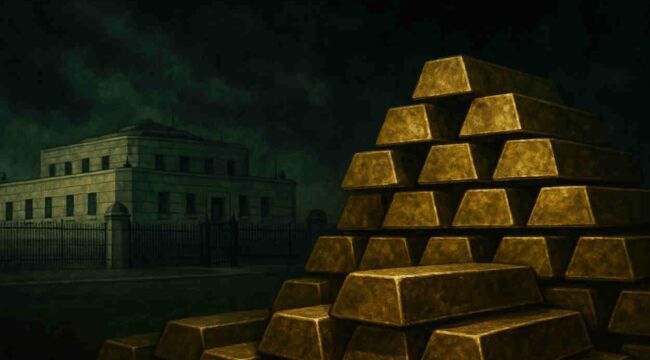The Truth About Fort Knox and Gold Leasing
Whatever happened to the Donald Trump and Elon Musk visit to Fort Knox?
You’ll recall the buzz from earlier this year. Trump and Musk loudly announced they were going to visit the U.S. bullion depository at Fort Knox, Kentucky to make sure the U.S. gold was actually there. The press was invited to tag along. Musk claimed that his DOGE team was ready to “audit” the gold bars to see that there were none missing. I had my own views on the announcement (described below) but I certainly agreed this would be the mother of all photo ops.
For the record, the U.S. Treasury holds 8,133.5 metric tonnes of gold in the U.S. reserve position. Slightly less than half of this gold is stored in Fort Knox. The remainder is mostly stored in a secure vault at West Point, New York. The exact location of that vault is classified although I happen to know where it is. A small amount is held at the Denver Mint for coinage purposes. Legally the U.S. Treasury owns the gold reserve, but I point out that the U.S. Army actually controls it since almost all of the gold is stored on two Army bases – Fort Knox and West Point.
A Fort Knox Extravaganza
None of this nuance about storage and location deterred Trump and Musk. In the popular imagination, all of the gold is in Fort Knox. That’s where they were headed to prove once and for all that the gold was actually there. Elon Musk planned to livestream the entire visit using his Starlink satellite system. Trump vaguely threatened that if any gold were missing, there would be disastrous consequences for any wrongdoers who removed it. The plot was set. The drama seemed irresistible.
As an aside, I was hoping that Trump and Musk were each reasonably fit and had been lifting some free weights. Gold is heavy! In fact, it’s one of the most dense materials in the periodic table of the elements, leaving aside radioactive elements like uranium and some of the trace elements that only exist in minute atomic-level quantities. A standard 400-Troy Ounce bar weighs 27.4 pounds in the English system. I’ve lifted a few during my visits to secure gold vaults. I always smile for the camera, but inside it takes a lot of strength to keep the gold bar in the air. I was concerned that Trump or Musk might strain their backs putting on a show for the press.
Trump mentioned the proposed visit to Fort Knox in a meeting with French President Emmanuel Macron. He mentioned it to reporters aboard Air Force One. He mentioned his plan again in remarks before the National Governors Association Conference and at the Conservative Political Action Committee (CPAC) annual meeting.
Then suddenly the whole story went away. Trump never mentioned it again after February 26. Musk went radio silent on the topic after April 6. There was no visit to Fort Knox. There was no announcement about why there would be no visit. It was as if the whole story never happened. It just went away.
Now, Elon Musk is leaving his position as head of the Department of Government Efficiency (DOGE). That was always in the cards. Musk’s appointment was as a temporary government employee; he was always going to leave about now. But why not put on a memorable gold show during his time in office? It simply never happened.
The Question Is, Why?
Let’s answer that beginning with the obvious point that the gold is all there. There have been rumors of missing and stolen gold almost from the day the bullion depository was built. Some suggested that European bankers stole the gold in the 1930s. Others said the Rockefeller clan looted the gold. The 1964 James Bond film Goldfinger is built around a plot to steal the gold.
This speculation makes for good rumor-mongering but, in fact, the gold is all present and accounted for. The last public audit was conducted in 1974, but annual audits are done by the U.S. Treasury (although the results are not made public). Treasury Secretary Scott Bessent recently said, “I can tell the American people … all the gold is there.”
If the gold is there (and it is), then why not go ahead with the visit? It would be great PR in any event and would reassure a skeptical American public.
A Money Monopoly
There are two reasons why the visit did not proceed and why you won’t hear more about it. The first one is that the U.S. government and the Federal Reserve (Fed) do not want to call attention to gold’s role as a monetary asset. The Fed (along with commercial banks) has a monopoly on the money printing press. The government has done everything possible to diminish and deny the role of gold as money, beginning with FDR’s confiscation of gold from U.S. citizens in 1933 and continuing through Nixon’s closing of the gold window for foreign trading partners in 1971. At this point, we have three generations of students since 1971 who know almost nothing about gold.
Gold is not taught in economics classes. Gold is not discussed in economic or Fed policy circles. Younger students don’t even know that the U.S. was ever on a gold standard or that gold once circulated freely as a form of money (usually in ¼-ounce or 8-gram coins). The government has eradicated any memory of gold as money. Why bring it back to life with a high-profile visit to Fort Knox? Better just to ignore gold if you want to maintain your money monopoly.
Of course, gold is a monetary asset. As noted, the U.S. has 8,133 metric tonnes (tonnes). Germany has 3,351 tonnes. Italy has 2,452 tonnes. France has 2,437 tonnes. Russia has 2,333 tonnes. And China reports that they have 2,292 tonnes although they are non-transparent and probably have much more. Among multilateral institutions, the European Central Bank has 506 tonnes and the IMF has 2,814 tonnes. If all of the members of the Euro area including the ECB combined their gold holdings, they would have 10,770 tonnes. All of these holdings should be put in the context of 36,118 tonnes, which is the amount of combined official gold holdings of every country in the world.

The Top 10 Gold Reserve Holdings By Country
Why have such large gold holdings persisted for a century or more in some cases and increase on a continual basis if gold is not money? The question answers itself. Gold is a form of money.
It’s simply the case that major countries don’t want to acknowledge it because they want to maintain their monopoly on paper money, or they are still acquiring it and don’t want to spike the price, at least until they complete their acquisition programs. One of the Marx Brothers’ classic punchlines was, “Who ya gonna believe … me or your own eyes?” When it comes to gold, I believe my own eyes. Official holdings of 36,118 metric tonnes of gold bullion tell me all I need to know.
The Leasing Scheme
There’s another even more insidious reason why Trump and Musk backed off from their Fort Knox visit. Even allowing for the fact that the gold is actually in Fort Knox the deeper question is whether that gold is leased?
Gold leasing is an established market but not well-understood by non-specialists. Even experts in stocks and bonds know little about gold leasing. Basically, it’s a way for a gold holder to earn a return. Gold does not pay dividends or interest like stocks and bonds. But you can lease it to a third party and make 2% or so annually in lease payments. The party leasing the gold does not back up a truck and take it away. The gold stays in the original vault. Gold leasing is a purely paper transaction.
The gold lessor gets the lease payment. The lessee gets what’s called a right of rehypothecation. That means the lessee can lease the same gold to another party. And that party can lease it to a fourth party and so on. With rehypothecation in play, one metric tonne of gold could support 100 metric tonnes of “paper gold” transactions.
At each step in the chain, a party acts like it owns the gold for its own purposes of further leases or sales of “unallocated” gold. Everyone has price exposure and can make money if the price of gold goes up or lose money if the price of gold goes down. The same principle applies to gold futures, gold options, gold swaps, gold ETFs and an entire world of gold derivative transactions. The point is that the paper gold world is leveraged about 100:1 to the physical gold world starting with the physical gold in Fort Knox.
The danger is obvious. It’s no different than any run on the bank when it comes to bank deposits. If a group of paper gold investors suddenly demands physical delivery, the counterparties have to buy gold in the spot market since the leased gold is not in their physical possession. The gold market is liquid, but not liquid enough to support delivery if there were demand for more physical than a small slice of the paper gold market. A full-scale gold panic could emerge quickly. The spot price of gold would go to $25,000 per ounce before an investor could yell “buy!”
I take it that someone (possibly Scott Bessent) sat down and patiently explained the paper gold reality to Trump and Musk.
Once you understand how the market actually works, you quickly back away from putting on a show at Fort Knox. For the masterminds of the paper gold market at JPMorgan and Goldman Sachs, the less said about gold the better. They need to keep the game going. And that’s why Trump and Musk won’t be showing up at Fort Knox anytime soon.
For the rest of us, the solution to this problem is simple – buy gold.



Comments: